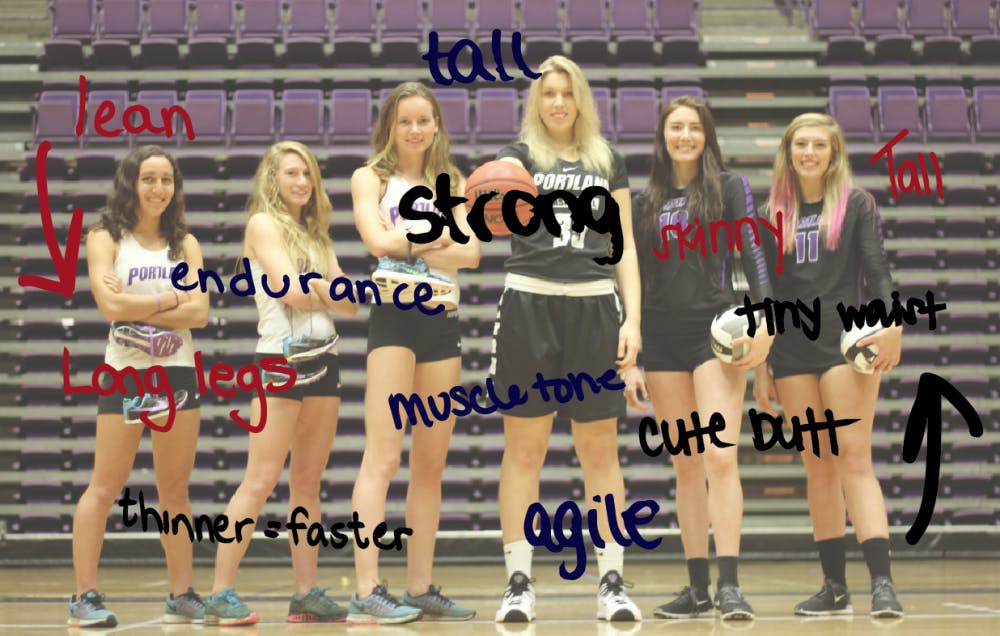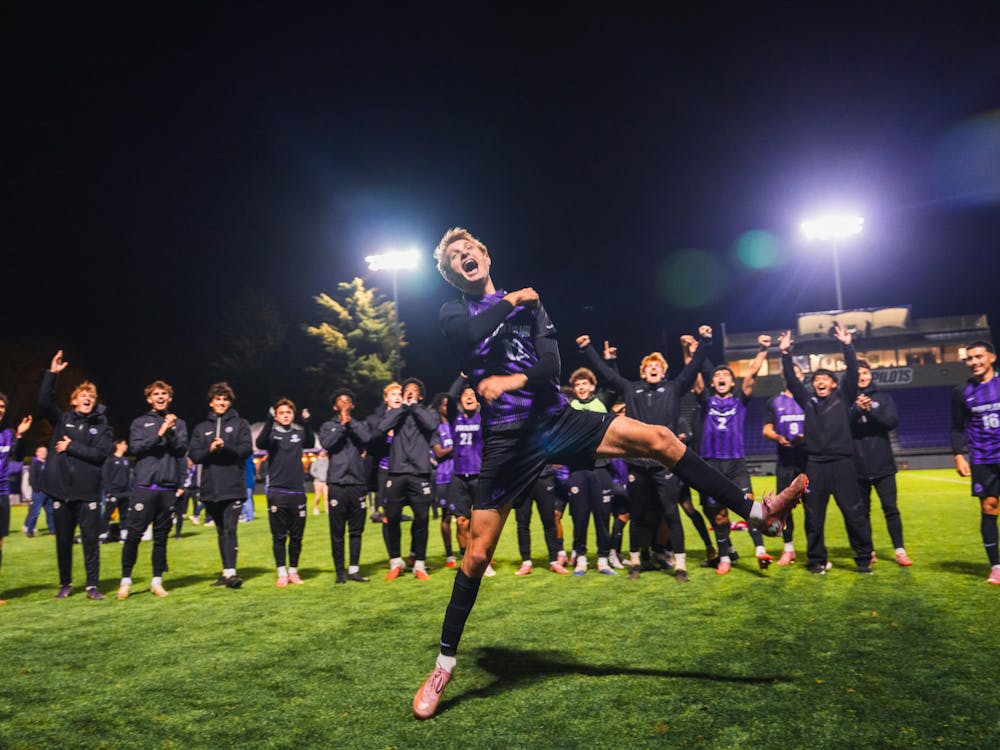By Malika Andrews |
Be skinny, but not too skinny. Be able to fill out your spandex, but don’t have thick thighs. Be muscular, but — careful — if you’re too muscular, you will look like a man. Be tall, but not taller than the boys.
Many women and girls struggle with body image issues, and athletes are no exception. They feel the pressure to walk the line between what it means to live up to beauty ideals that society promotes and being strong for their sport.
The struggle is manifested in a variety of ways.
For UP cross country runner Jane (a pseudonym), the pressure of being thin became so intense, she took time off of school to regain control.
Women’s basketball player Sarah Zaragoza gave up high heels because with them on, she was “too tall” to be feminine.
For volleyball players Emily Liger and Maddy Mandon, the spandex they are required to wear makes them feel exposed.
It’s a cycle of perfection and body obsession coupled with high self-expectations and desire for perfection.
Qualities of successful athletes often mirror symptoms of eating disorders: perfection, control and self-criticism. In fact, female athletes are almost two times more likely than the average woman to develop disordered eating and issues surrounding body image, according to the National Eating Disorders Association.
Female athletes at UP report not only struggling with weight, but also hypersexualization of their sport and the notion that there is always something they could be doing better. Some have gone to the extremes of stuffing their bras with iPhones to make them pass weight checks, while others are self-conscious of how their bodies look in the revealing uniforms they are required to wear.
‘Some girls would just disappear…’
“(In cross-country) being good overrides being healthy,” Jane said.
At least that was her perception. And being good meant being thin.
Jane would allow herself to consume 1,500 calories every day for a year, during which she ran 70 miles a week as a competitive collegiate athlete. Her disordered eating began when she was running for a large state university and was required to weigh herself three times a week.
“It was horrible,” Jane said. “I would eat because I can’t starve myself but if I ate one more calorie a day than I should, I would go for a walk…it was so scary.”
When her parents realized the problem, they pulled her out of school. She remained home for a year and a half before she transferred to UP and was healthy enough to return to school and cross country.
It wasn’t like Jane had a secret. Quite the opposite. She fell into a norm for many cross country runners. It’s a sport-wide unspoken rule: Thinner is better. If losing a few pounds is good, losing a lot of weight must be excellent. Performance is the most important thing.
“If you go to the trainer and you are a little bit underweight they aren’t going to be like, ‘You have an eating disorder,’ and kick you off the team because if you are the best runner, you are the best runner,” Jane said.
According to assistant athletic trainer Amy Carrol, trainers at UP are not specifically trained to deal with eating disorders. When those symptoms are noticed, the athletic staff outsources to the Health Center and in necessary cases, treatment centers outside the university.
Runner Anna Farello said part of the problem is that the runners whom lots of athletes look up to are all skinny, some of them unhealthily so.
“They are all professionals, thin and super fast,” Farello said. “It’s hard to ignore that.”
“They all have really low body fat,” runner Lindsay Tompkins added.
Being thin works, to a point. But at some point, being thin is counterproductive and the body begins to deteriorate. Coach Bradford Scott, the director of athletic performance, weighs all the athletes as part of his program, but works hard to avoid making it the emphasis.
“With weight, it shouldn’t matter what the scale says,” Scott said. “Our whole goal is performance. So if we are tracking body weight, like let’s say a team weighs in consistently, it’s more or less are they performing to their capabilities? It has nothing to do with taking a body fat image and saying, ‘Here’s your ideal.’”
Senior cross country runner Anne Luijten said the culture surrounding body image has improved since her freshman year, where she saw girls starving themselves to fit their body image ideals.
“When I came in, there was a really weird atmosphere on the team because we had like four or five too skinny runners who were all on varsity,” Luijten said. “Then, some girls would just disappear from training all together…It wasn’t like, ‘This person isn’t running anymore because they need to gain weight.’ They just disappeared from training and then some point they appeared again.”
The team later found out that these athletes could not participate because they were unhealthily thin, but it was not something the team discussed.
It is not exclusively a University of Portland runners’ issue.
“I think it is an issue in our sport to an extent and our team is not immune from that,” Coach Ian Solof said. “But I think by and large it is an individual issue.”
Solof said that having one person on the team with an eating disorder can rub off on other teammates to create a negative body image culture.
Currently, Solof said that the team is in a good place with body image and he tries to have his team focus on “training right and training smart.”
‘Why do we have to wear that?’
For some female athletes, uniforms trigger body issues.
In volleyball, women wear a skintight shirt and short spandex, a far more revealing uniform than their male counterparts, who wear nearly knee length shorts.
“You’re basically naked,” sophomore volleyball player Maddy Mandon said. “You’re not wearing clothes.”
The NCAA does not require volleyball players to wear spandex. The rulebook states that, “Playing uniform consists of jersey plus shorts/briefs, pants or culottes.” Still, it has become the norm, leaving little to the imagination.
“I’ve worn spandex since I was 12, and the whole idea of volleyball being sexualized, it never really struck me,” Mandon said. “It’s just a requirement. I mean I’d rather wear running shorts or basketball shorts, but it’s part of the uniform.”
Revealing uniforms can lead to body dissatisfaction. According to the NCAA, “a study in volleyball found not only that revealing uniforms contributed to decreased body esteem but also distracted players and negatively affected sport performance.”
Liger’s uniform distracts her and she is constantly tugging her spandex down during games and practice.
“It is weird if you think about it,” Liger said. “Like, why do we need to wear that? My jersey is so tight…there is no extra room. Maybe more people would play the sport if we didn’t have to wear spandex.”
Liger isn’t the only one that notices. And with the addition of beach volleyball to the university’s sport roster next semester, the issue may become more prevalent.
In the coverage of the 2012 Olympics, London mayor Boris Johnson wrote that the reason that beach volleyball is so popular are the “semi-naked women” and compared the athletes to “glistening wet otters.”
While UP athletes will not wear bikinis, Liger says they might as well.
“The NCAA uniform is tanks and spandex but we might as well play in a bikini because it’s so tight,” Liger said. For coach Nellie Coleman, who played on Team USA in 2008-2013, the focus shouldn’t be on the way athletes’ bodies look, but the amazing things they can do.
Coleman, then Nellie Spicer, was featured in ESPN’s 2012 “Bodies We Want” feature, an appearance she’s proud of because the section celebrates male and female athletes of all different shapes and builds.
“I looked at old issues and I think they do a really good job and the message to show all these young athletes that you can have any type of body, it doesn’t matter, you can still reach the USA national team, you can go to the Olympics...everyone is different,” Coleman said.
‘How tall are you? Like 6’9”?’
It’s easy to spot the basketball players on campus. While this attention may be perceived positively, the female players are often uncomfortably aware that they stand a head taller than everyone else.
Sophomore Sara Zaragoza is 6’4” which, as a center, is perfect. Off the basketball court though, she says it is not ideal. “If you are tall, that’s good,” Zaragoza said. “But you have other problems outside of basketball. For me, it is so hard to find clothes. I have a size thirteen shoe in men. It is really hard.”
Zaragoza loves wearing high heels, but doesn’t. She said she’s afraid of what people will think. She has confidence on the court, where her height is an advantage, but off the court it draws negative attention. Zaragoza says that people will often joke with her, “How tall are you? Like 6’9”?”
The joke isn’t funny. She’s heard it before.
Ashley Gray, said that she has the opposite problem. At 6’1”, she is undersized for playing center, but once she realized she was no longer the biggest or the strongest, she embraced her size and role on the court.
“It was just a matter of being stronger than the girls that are taller,” Gray said. “Because if you have the physicality on them, it doesn’t matter.”
Head basketball coach, Cheryl Sorenson, says height is something she considers when she is looking at recruiting players because “long, lean players” are more versatile. But height is not the reason she will rule out a player.
“I think that is certainly something we look at,” Sorenson said. “Body type and then what are they going to be because we are looking at them as 15, 16-year-olds, what are they going to look like when they are 20 or 21?”
Sorenson said that in the past she has even looked at players’ parents to get a better idea of their size and shape. Being 5’11” herself, Sorenson understands the stigma that can accompany being a tall woman and attempts to address it with her players by instilling confidence in her players’ height. She tells them height is a “blessing.”
“What I try to do is instill confidence so that hopefully when they graduate here, they are still tall, beautiful, confident women that are taking things on in the workplace,” Sorenson said.
Her message to her team might benefit all female athletes.
“We try to just instill confidence no matter what their height or shape is.”
Malika Andrews is the Sports Editor for The Beacon. She can be reached at andrewsm17@up.edu or on Twitter @malika_andrews.
Editors Note:
The Beacon has a policy to generally avoid the use of anonymous sources because we believe that our readers are entitled to know the identities of sources of information so they can evaluate for themselves their credibility.
We may make exceptions when we believe the public benefit of publishing a story that could best be told only with an anonymous source or sources outweighs the value of the policy.








